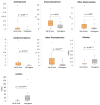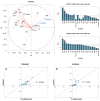Bacterial Complexity of Traditional Mountain Butter Is Affected by the Malga-Farm of Production
- PMID: 35056468
- PMCID: PMC8778680
- DOI: 10.3390/microorganisms10010017
Bacterial Complexity of Traditional Mountain Butter Is Affected by the Malga-Farm of Production
Abstract
Bacteria can play different roles affecting flavors and food characteristics. Few studies have described the bacterial microbiota of butter. In the present paper, next-generation sequencing was used to determine bacterial diversity, together with aromatic characteristics, in raw cow milk butter processed by traditional fermentation, in fourteen small farms called "Malga", located in the Trentino province (Alpine region, North-East of Italy). The physicochemical and aromatic characterization of traditional mountain butter (TMB) showed a low moisture level depending on the Malga producing the butter. Counts of lactic acid bacteria, Staphylococci, and coliforms, as well as diacetyl/acetoin concentrations exhibited changes according to the geographical origin of Malga and the residual humidity of butter. MiSeq Illumina data analysis revealed that the relative abundance of Lactococcus was higher in TMB samples with the highest values of acetoin (acetoin higher than 10 mg/kg). The traditional mountain butter bacterial community was characterized by a "core dominance" of psychrotrophic genera, mainly Acinetobacter and Pseudomonas, but according to ANCOM analysis, a complex bacterial population emerged and specific bacterial genera were able to characterize the TMB bacteria community, with their high abundance, based on the Malga producing the butter.
Keywords: Illumina MiSeq; Lactococcus; Malga; acetoin; bacterial counts; butter; raw milk.
Conflict of interest statement
The authors declare no conflict of interest.
Figures





References
-
- Rousseau D. Fat crystals and emulsion stability—A review. Food Res. Int. 2000;33:3–14. doi: 10.1016/S0963-9969(00)00017-X. - DOI
-
- Disciplinare di Produzione del Botìro di Primiero di Malga. [(accessed on 17 December 2021)]. Available online: https://www.tastetrentino.it/fileadmin/user_upload/download/Disciplinare....
-
- Andreo I., Doval M.M., Romero A.M., Judis M.A. Influence of heating time and oxygen availability on lipid oxidation in meat emulsions. Eur. J. Lipid Sci. Technol. 2003;105:207–213. doi: 10.1002/ejlt.200390042. - DOI
LinkOut - more resources
Full Text Sources

